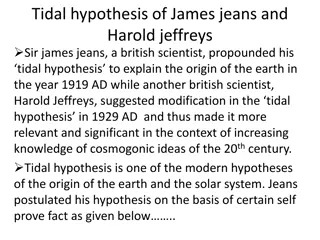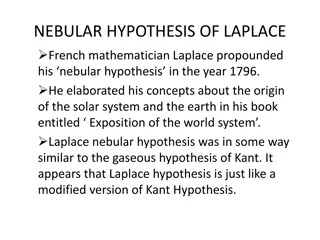Human Evolution: Out of Africa Hypothesis
The Out of Africa Hypothesis suggests that humans originated in Africa and then migrated to other parts of the world in two waves. The first migration occurred around 100,000 years ago, following the Nile River into the Middle East. The second migration, approximately 85,000 years ago, saw a group of Homo sapiens moving into the Arabian Peninsula and further into Asia and China. Two main hypotheses explain this migration: following migrating herds for prey or population pressure forcing groups to seek new territories. Fossil and genetic evidence support the theory of human migration out of Africa.
Download Presentation

Please find below an Image/Link to download the presentation.
The content on the website is provided AS IS for your information and personal use only. It may not be sold, licensed, or shared on other websites without obtaining consent from the author.If you encounter any issues during the download, it is possible that the publisher has removed the file from their server.
You are allowed to download the files provided on this website for personal or commercial use, subject to the condition that they are used lawfully. All files are the property of their respective owners.
The content on the website is provided AS IS for your information and personal use only. It may not be sold, licensed, or shared on other websites without obtaining consent from the author.
E N D
Presentation Transcript
LIFE SCIENCES GRADE 12 CAPS STRUCTURED, CLEAR, PRACTICAL - HELPING TEACHERS UNLOCK THE POWER OF NCS KNOWLEDGE AREA: Diversity, Change and Continuity TOPIC 4.2:Human Evolution Out of Africa Hypothesis
SUMMARY OF PRESENTATION: What does the hypothesis state? Lines of Evidence to Support the Out of Africa Hypothesis. Fossil Record as Evidence for the Out of Africa Hypothesis.
WHAT DOES THE HYPOTHESIS STATE? According to this hypothesis Humans originated in Africa then moved out of Africa to all parts of the world. This started about 160 000 years ago, when humans migrated north to North Africa. Then about 120 000 years ago they migrated south as far as South Africa. Map showing the migration of humans
WHAT DOES THE HYPOTHESIS STATE? There were 2 lines of migration. The first humans migrated out of Africa about 100 000 years ago. 1 They followed the Nile River and then crossed into the Middle East . First migration
WHAT DOES THE HYPOTHESIS STATE? The second migration was about 85 000 years ago. During which a group of Homo sapiens migrated into Arabian Peninsula. From there the humans travelled along the coastline into Asia and finally China. The second migration
WHAT DOES THE HYPOTHESIS STATE? There are 2 hypothesis to explain the reason for the migration. The first hypothesis believes that the humans simply followed their prey, which were migrating herds. When the climate was right, even parts of the Sahara Desert was green with vegetation. Therefore the humans and the herds were able to migrate across the Sinai Peninsula into the Middle East.
WHAT DOES THE HYPOTHESIS STATE? The second hypothesis believes that population pressure forced some groups to migrate. This means that the competition for food, shelter increased, forcing some humans to move. They moved during moist climatic periods . This hypothesis is based on fossil and genetic evidence. Lets now study this evidence
LINES OF EVIDENCE TO SUPPORT THE OUT OF AFRICA HYPOTHESIS Fossil Evidence: 1. The oldest fossils are found in Africa. These are the fossils of Homo ergatser and H. sapiens. The intermediate stages between H. ergaster and H. sapiens are only found in Africa. This is supported by the transitional fossil evidence. Now lets look at some of these fossils that were found in Africa.
LINES OF EVIDENCE TO SUPPORT THE OUT OF AFRICA HYPOTHESIS The following fossils were found in and around the Cradle of Humankind Taung child: This is a 2.6 to 2.8 million year old fossil. It is an example of Australopithecus africanus. It was discovered by Robert Dart in 1924, in the village of Taung in the Northern Cape. a) Taung child
LINES OF EVIDENCE TO SUPPORT THE OUT OF AFRICA HYPOTHESIS Mrs Ples Another example of Australopithecus africanus. This is the adult form of the Taung child. This fossil was found in the Sterkfontein caves in 1947 by Robert Broom. b) Mrs Ples
LINES OF EVIDENCE TO SUPPORT THE OUT OF AFRICA HYPOTHESIS Kromdraai The fossil of Paranthropus robustus called Kromdraai was discovered in 1938. This discovery was made by Robert Broom. The fossil was discovered 1.4km from Sterkfontein caves. c) Kromdraai
LINES OF EVIDENCE TO SUPPORT THE OUT OF AFRICA HYPOTHESIS d) Florisbad man This is an earlier form of Homo sapiens. This fossil was 250 000 years. It was found in Florisbad in the Free State in 1932 by Prof. T.F Dreyer. Florisbad man
LINES OF EVIDENCE TO SUPPORT THE OUT OF AFRICA HYPOTHESIS Much older hominid fossils were found in East Africa, just east of the Great Rift Valley. The location of the Great Rift Valley is shown in the map alongside. Lets look at some of these fossils Great Rift Valley
LINES OF EVIDENCE TO SUPPORT THE OUT OF AFRICA HYPOTHESIS The Nutcracker man. The scientific name of this fossil is Paranthropus boisei. This fossil is 1.2 to 2.2 million years old. It was discovered in the Olduvia Gorge in Tanzania in 1959. This discovery was made by Mark and Louis Leaky. a) The Nutcracker man
LINES OF EVIDENCE TO SUPPORT THE OUT OF AFRICA HYPOTHESIS Ardi (Ardipithecus) b) This is a 4-6 million year old fossil. It was discovered by Tim White in Ethiopia between 1992-1993. At this point they found 17 fragments of the skull, mandible, teeth and arm bones. Ardi (Ardipithecus)
LINES OF EVIDENCE TO SUPPORT THE OUT OF AFRICA HYPOTHESIS At first it was though to be Australopithecus. Then between 1999 and 2003 bones and teeth were of 9 more specimens were discovered in the same region by Sileshi Semaw. Further studies proved it to be a new genus. It was named Ardipithecus. There were 2 species of Ardipithecus. These were ramidus and kadabba. A. ramidus was younger and lived about 4.4 million years ago. A. kadabba lived about 5.6 million years ago.
LINES OF EVIDENCE TO SUPPORT THE OUT OF AFRICA HYPOTHESIS Handy man (Homo habilis) c) This is the oldest species of the genus Homo. It was discovered by Peter Nzube in 1948. This discovery was made in the Olduvai Gorge in Tanzania. Homo habilis
LINES OF EVIDENCE TO SUPPORT THE OUT OF AFRICA HYPOTHESIS Laetoli Footprints d) These footprints are 3.6 million years old. They are actually footprints made in volcanic ash. They were discovered by Mary Leaky, in 1978. This discovery was also made in Tanzania. Laetoli Footprints
LINES OF EVIDENCE TO SUPPORT THE OUT OF AFRICA HYPOTHESIS Toumai (Sahelanthropus tchadensis) e) This is a 7 million year old fossil. This is the first bipedal primate. It was discovered in Chad in 2001 by Michael Brunet. Chad is not in the Great Rift Valley. Laetoli Footprints
LINES OF EVIDENCE TO SUPPORT THE OUT OF AFRICA HYPOTHESIS They had the following features Forward position foramen magnum, therefore a bipedal. Small brain size Prominent brow ridges Small canine teeth , like the later hominids The above features suggest that it is a close common ancestor of both the chimpanzee and humans. 1. 2. 3. 4.
LINES OF EVIDENCE TO SUPPORT THE OUT OF AFRICA HYPOTHESIS Lucy: f) This fossil is 3.2 million years old. It was discovered in Ethiopia by Donald Johanson, Yves Coppan and Tim White. It was discovered in 1974. It was about a meter in height and weighed about 30-45kg. Lucy
LINES OF EVIDENCE TO SUPPORT THE OUT OF AFRICA HYPOTHESIS Lucy is an example of Australopithecus afarensis. It has the following features A forward position foramen magnum bipedalism. Cranial capacity of 375 to 550 cc (cubic centimeter) 1. 2. Lucy
LINES OF EVIDENCE TO SUPPORT THE OUT OF AFRICA HYPOTHESIS The skull is more chimpanzee like. The teeth are similar to that of a human. Canines are smaller than those found in apes but they are much larger than those found on modern man. 3. 4.
LINES OF EVIDENCE TO SUPPORT THE OUT OF AFRICA HYPOTHESIS Finally in August 2012 a new fossil was discovered in Kenya. This fossil was discovered by Maeve Leaky. This fossil points to another species that lived alongside the Homo erectus. New fossil discovered in 2012
LINES OF EVIDENCE TO SUPPORT THE OUT OF AFRICA HYPOTHESIS Lets summarize the fossils The earliest primate is the Sahelantropus tchadensis Toumai This was followed by the 5.6 million years old Ardipithecus kaddaba. Then the 4.4 million year old Ardipithecus ramidus. 1. 2. 3.
LINES OF EVIDENCE TO SUPPORT THE OUT OF AFRICA HYPOTHESIS Then the Australopithecus appeared 4 million years ago. We looked at the following examples Lucy ( 3.2 million years old), Taung child (2.6 to 2.8 million years old), Mrs Ples (2.6 million years old), Little foot (3.9 to 4.2 million years old) and finally Karabou ( 1.78 to 1.98 million years old). 4. This genus had the following features Protruding jaws Prominent brow ridges Long sloping faces Small brain (300-600 ml) Short-1.2m tall
LINES OF EVIDENCE TO SUPPORT THE OUT OF AFRICA HYPOTHESIS Homo Species Australopithecines gave rise to the first early human Homo habilis. This was 2 million years ago. Then 1.5 million years ago H. habilis gave rise to H. erectus. Then H. erectus gradually gave rise to about 150 000 to 200 000 years ago. H. sapiens At the time of Homo sapiens there were at least 4 other species of Homo. These were the Homo neanderthalensis, Homo antecessor, Homo florensiensis and Homo heidelbergensis. 5.
LINES OF EVIDENCE TO SUPPORT THE OUT OF AFRICA HYPOTHESIS These species were outcompeted by H. sapiens and therefore became extinct. Simply put the fossil evidence for the Out of Africa Hypothesis is A large number of very old fossils of H. ergaster and H. sapiens were found in Africa. Transitional fossils between H. ergaster and H. sapiens were only found in Africa. 1. 2.
LINES OF EVIDENCE TO SUPPORT THE OUT OF AFRICA HYPOTHESIS Genetic Evidence 2. There are lines of evidence for both males and females. When DNA is used to trace ancestry, mutations are studied. Because mutations are passed down from parent to offspring. This means that the mutations are markers of descent. Now lets look at evidence for both males and females.
LINES OF EVIDENCE TO SUPPORT THE OUT OF AFRICA HYPOTHESIS DNA from the Y chromosome: a) Remember males have a XY gonosome. The Y chromosome experiences very little crossing over. This means that most of the DNA in the Y- chromosome is passed on from father to son. And is not mixed with the DNA from the mother because of the limited crossing over. This means that any mutant DNA can be traced from father to grand father and to great grandfather and so on.
LINES OF EVIDENCE TO SUPPORT THE OUT OF AFRICA HYPOTHESIS This was used by Spencer Wells and his colleagues who were able to trace the male linage of every man alive today to a 60 000 year old common ancestor . This ancestor lived in East Africa. Mitochondrial DNA Remember during fertilization only sperm nucleus fuses with the egg nucleus. The egg then becomes one of the cells in the zygote. b)
LINES OF EVIDENCE TO SUPPORT THE OUT OF AFRICA HYPOTHESIS This means that the mitochondria of the egg becomes the mitochondrion of the zygote. Therefore the mitochondrial DNA are not mixed with any other DNA. Therefore mtDNA is passed down from mother to daughter. The female line can be traced using the mutant nucleotides . The evidence shows that the mitochondrial DNA can be traced back to 150 000 years to an ancestral female in East Africa.
SOMETHING FOR YOU TO DO Describe TWO lines of evidence which support the idea that the human population had its origins on the African continent. (4)
SOLUTION The oldest fossils of Australopithecines/Homo habilis/ bipedal have only been found in Africa - The oldest fossils of Homo erectus have been found only in Africa - Analysis of mitochondrial DNA shows that the oldest female ancestors of humans are from Africa - Analysis of Y chromosome shows that the oldest male ancestors of humans are from Africa.
SOMETHING FOR YOU TO DO: Study the table below, which indicates some of the hominid fossils found in the world and answer the questions that follow. SPECIES REGION WHERE IT WAS FOUND PERIOD OF EXISTENCE (WHEN IT LIVED) Australopithecus afarensis Eastern Africa 3,4 2,8 mya Australopithecus africanus Southern Africa 2,1 2,8 mya Australopithecus sediba Southern Africa 2,0 1,9 mya Homo habilis Sub-Saharan (Africa) 2,3 1,4 mya Homo erectus Africa, Europe, Asia 1,5 0,2 mya Homo heidelbergensis Europe, China 0,6 0,35 mya Homo neanderthalensis Europe, Western Asia 0,35 0,03 mya Homo sapiens Worldwide 0,2 mya present
SOMETHING FOR YOU TO DO Explain why the information in the table supports the 'Out of Africa' hypothesis. If a fossil of Australopithecus afarensis, dated 3,2 mya, is found in Asia, explain the implications for the 'Out of Africa' hypothesis. Describe TWO genetic lines of evidence that support the 'Out of Africa' hypothesis. 1. 2. 3.
SOLUTION The oldest fossils of hominids (Australopithecines and Homo habilis) are only found in Africa, whilst the younger fossils are found worldwide which suggests that humans originated in Africa. The oldest Homo erectus fossils was found in Africa and later in Europe and Asia, which suggests that Homo erectus migrated out of Africa . The hypothesis will be rejected. It would imply that the origins of humans is in Asia not Africa 1. 2.
SOLUTION Mutations in mitochondrial DNA (mtDNA)can be traced to a female ancestor in Africa Mutations in Y chromosome can be traced to a male ancestor in Africa 3.
QUESTION 1 An opening on primate skulls through which the spinal cord passes is the A. Foramen magnum B. Vertebral column C. Both A and B D. Neither A nor B 1.
QUESTION 2 Fossils found in South Africa were A. Australopithecus sediba ('Karabo') B. Mrs Ples C. Both A and B D. Neither A nor B 2.
QUESTION 3 Capable of bipedal locomotion A. Homo erectus B. Australopithecus africanus C. Both A and B D. Neither A nor B 3.
QUESTION 4 Below is a list of fossils discovered in South Africa. 1. Mrs Ples 2. Taung child 3. Little foot 4. Karabo 4. Which of the fossils above are classified in the genus Australopithecus? A. 1, 2 and 3 only B. 1, 2, 3 and 4 C. 2, 3 and 4 only D. 2, 3 and 4 only
QUESTION 5 The evidence used to support the 'Out of Africa' hypothesis tracing the maternal lineage is A. Y chromosome B. Mitochondrial DNA C. Both A and B D. Neither A nor B 5.
QUESTION 6 First Homo species to have migrated out of Africa is A. Homo habilis B. Homo sapiens C. Both A and B D. Neither A nor B 6.
QUESTION 7 Fossils found in South Africa are A. Mrs Ples B. Lucy C. Both A and B D. Neither A nor B 7.
QUESTION 8 Fossil that has a brain of between 300 to 350 cc and a grasping big toe is A. Ardipithecus ramidus B. Australopithecus afarensis C. Australopithecus sediba D. Plesianthropus 8.
QUESTION 9 Karabou is A. Ardipithecus ramidus B. Australopithecus afarensis C. Australopithecus sediba D. Plesianthropus 9.
QUESTION 10 10. Lucy is A. Ardipithecus ramidus B. Australopithecus afarensis C. Australopithecus sediba D. Plesianthropus
QUESTION 11 11. Handy man is A. Ardipithecus ramidus B. Australopithecus afarensis C. Australopithecus sediba D. Homo habilis
QUESTION 12 12. Mrs Ples is A. Ardipithecus ramidus B. Australopithecus afarensis C. Australopithecus sediba D. Plesianthropus

 undefined
undefined































